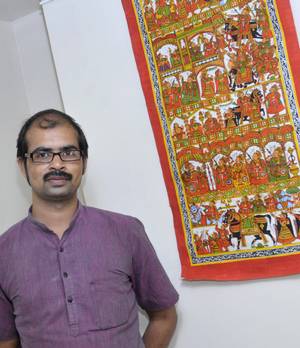Phad painting: Rajasthan
This is a collection of articles archived for the excellence of their content. |
Rajasthan
Shilpa Sebastian R, Drawn into family tradition, July 11, 2016: The Hindu

Phad is a 10 Century art. All the drawings are fixed. In realistic art we have long noses. In Phad, we have a round nose, large eyes and round face. If there is even a slight change in the depiction of the line, the art can be mistaken either for a Madhubani or patchitra. Even the colours here are fixed — orange, yellow, green, brown, blue, red and black. Most of the images are side profiles for we are drawing characters speaking to one another. Only the deities and demons are given a clear picture.
The drawings narrate stories about our local heroes – Pabu (believed to be a reincarnation of Laxman ) and Devanarayan (Vishnu avataar). The two men are relevant to Rajasthan's culture and a local priest, called Bhopa, looks at our drawings and narrates the stories of these heroes in the temples.
Artist Prakash Joshi
Shilpa Sebastian R, Drawn into family tradition, July 11, 2016: The Hindu
Rajasthan's Prakash Joshi teaches the traditional Phad style of mythology-based painting to youngsters, to keep this dying art alive. He does not allow students to use an eraser!
Prakash is from the well-known Joshi family in Rajasthan that has been into painting Phad art for almost 300 years. The first question is why he avoids erasers. The reply is: “So that the student can see his earlier mistake and avoid it. If he erases it, then the same mistake is continued. Avoiding an eraser also makes the student more alert and perfect,” says Prakash.
“I was not allowed to leave my hometown so I stayed back and started helping my father with his art.” Prakash took to the art of Phad when he was a child, from his well-known father Nand Kishore. “I would hang around and watch him at work and he would hand me a waste cloth and paint and ask me to do something. This was before I was 13; I was drawn into this family tradition,” recalls Joshi, who has also won several awards for his paintings. He was awarded the District Award and the State Award in 98, National Merit Award in 2008, National Award in 2009 and the Kalamani Award in 2010; he has no regrets that he could not become a CA.
In '98 he started teaching this art at a school called Chitrashaala in Bilwara. “This art is dying because men did not teach their daughters this art as they did not want the secret of the art to go to another family. But now with dwindling artists, this art is dying. So we teach anyone who is interested. There are a few girls and women who have learnt this art,” says Prakash, whose school also offers a certified course in Phad. The only prerequisite is that one has to be 15 years and above and have the basic knowledge of human anatomy.
As most paintings in Phad also include stories from Hindu mythology depicting deities, Prakash avoids painting them on bed sheets or saris. It takes Prakash anywhere from a month and above to create a piece of art. The sizes of his work vary from nine inch by 12 inch to five feet by 36 feet scrolls. “I sell my work only through exhibitions.”